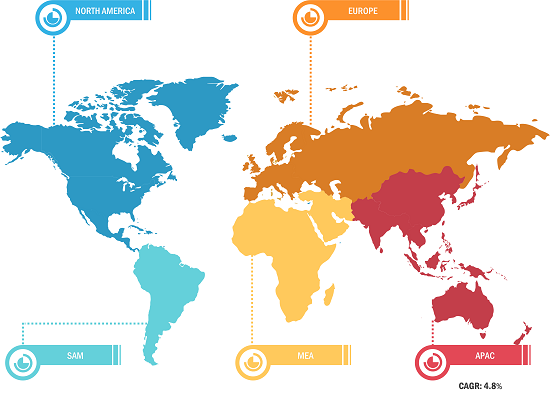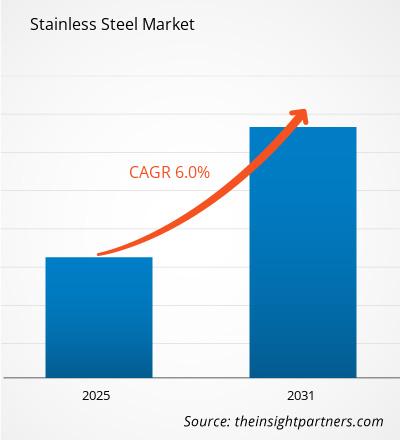不锈钢市场规模预计将从2021年的1969.9483亿美元增长到2021年的1969.9483亿美元到2031年将达到2667.8148亿;预计 2022 年至 2031 年复合年增长率为 4.5%。
不锈钢是一种铁合金,至少含有 10.5% 的铬。它是一种具有高耐腐蚀性、强度和制造特性的工程材料。在不锈钢中,添加碳、硅、锰和其他元素(例如镍和钼)以增强有用的性能,例如可成形性和增强的耐腐蚀性。不锈钢用于工业、建筑、化学和消费应用。 不锈钢市场的主要参与者正在关注战略例如并购以及新产品开发,以扩大其全球地域影响力和消费者基础。
2021年,亚太地区占据不锈钢市场最大的收入份额。亚太地区不锈钢市场的增长主要归功于发达国家和发展中国家工业的快速发展。该建筑和亚太地区的建筑业正在快速增长。印度、日本和澳大利亚等国家的快速城市化带动了基础设施的发展,进一步推动了不锈钢的需求。此外,该地区还拥有 Acerinox SA、Aperam SA、ArcelorMittal SA、Jindal不锈钢有限公司、Outokumpu OYJ、Sandmeyer 钢铁公司和 Sandvik AB 等主要不锈钢制造商。
战略见解
全球不锈钢市场细分 –按地区

市场洞察
汽车行业快速增长
由于对安全性、性能、效率、轻量化和强度的需求日益增长,不锈钢已成为汽车设计的前沿。由于不锈钢具有经济高效的结构设计、耐用性和效率等引人注目的特性,它已成为汽车行业的首选。不锈钢的耐腐蚀性能是其应用于装饰轮辋生产的重要原因。由于不锈钢的轻质特性,它被认为是制造燃料箱的主要材料。高强度不锈钢提供了生产重量更轻、更安全且保持其固有强度的燃料箱的机会。与多层聚合物油箱相比,不锈钢油箱的壁厚可以显着减小,从而有助于将油箱的重量减轻约 3.5 千克。不锈钢易于成型的特性有助于生产各种形状和尺寸的油箱。此外,不锈钢专门用于生产高性能汽车。
成绩洞察
基于成绩,全球市场细分为200系列、300系列、400系列等。 300 系列细分市场的不锈钢市场份额在 2021 年达到最大。300 系列不锈钢的铬含量约为 18-30%,镍含量为 6-20%,作为主要合金添加物。高温下仍能保持高强度,耐腐蚀,维护方便。低碳含量的 300 系列不锈钢是高延展性和重型焊接的首选。 300 系列不锈钢在环境温度下外部暴露于轻度腐蚀条件的应用中具有出色的耐受性。它非常适合并推荐用于所有标准焊接方法。 300 系列不锈钢的典型应用包括轨道车结构部件,这些部件通常采用辊压成型拉伸或辊压成型为型材。 300 系列不锈钢还用于雨刷片支架和夹子以及汽车轮盖。
不锈钢市场,按等级划分 - 2021 年和 2031 年
产品洞察
< p>根据产品,全球市场分为热棒/线材、半成品、冷棒/线材、冷轧扁钢、热卷、热板等床单。 2021年,冷轧板材市场的不锈钢市场份额最大。冷轧板材因其高强度、耐腐蚀、耐高温等特性而广受欢迎。除了这些性能之外,冷轧扁钢由于其优异的成型性和最小的机械性能偏差而变得越来越重要。冷轧板材产品有多种尺寸可供选择,厚度范围从 0.14 毫米到 3.2 毫米,宽度最大可达 1,850 毫米。全球不锈钢市场的一些参与者包括 Acerinox SA、Aperam SA、ArcelorMittal SA、Jindal 不锈钢有限公司、Outokumpu OYJ、Sandmeyer Steel Company、Sandvik AB、Schmolz + 比肯巴赫集团、蒂森克虏伯股份公司和广西成都集团。不锈钢行业的参与者专注于提供高质量的产品来满足客户的需求。他们还关注研发活动投资和新产品发布等战略。
报告焦点
- 不锈钢市场的进步行业趋势,帮助参与者制定有效的长期战略
- 采用的业务增长战略按发达市场和发展中市场划分
- 2021-2031年全球市场定量分析
- 全球不锈钢需求估算
- 各地区的 PEST 分析
- 了解竞争市场情况的最新进展
- 市场趋势和前景,以及推动和抑制不锈钢市场增长的因素
- 通过强调支持商业利益的市场策略来协助决策过程,从而促进市场增长
- 各个节点的不锈钢市场规模
- 市场详细概述和细分,以及不锈钢行业动态
- 具有良好增长机会的各地区不锈钢市场规模
全球不锈钢市场
全球不锈钢市场按牌号分为200系列、300系列、400系列等。市场按产品分为热棒/线材、半成品、冷棒/线材、冷轧板材、热卷材和热板及薄板。按应用划分,不锈钢市场分为汽车和运输、建筑、消费品和其他金属部件、重工业和电器。 .
公司简介
-
- 历史分析(2 年)、基准年、预测(7 年)及复合年增长率
- PEST 和 SWOT 分析
- 市场规模价值/数量 - 全球、区域、国家
- 行业和竞争格局
- Excel 数据集



Report Coverage
Revenue forecast, Company Analysis, Industry landscape, Growth factors, and Trends

Segment Covered
This text is related
to segments covered.
Regional Scope
North America, Europe, Asia Pacific, Middle East & Africa, South & Central America

Country Scope
This text is related
to country scope.常见问题
What is the future trends for stainless steel market?Increased focus on eletropolishing and surface treatments is expected to be the key market trends
What are the deliverable formats of the stainless steel market?The report can be delivered in PDF/Word format, we can also share excel data sheet based on request.
Which regions are covered in the report?On the basis of geography, the stainless steel market is classified into North America, Europe, Asia Pacific, Middle East and Africa, and South and Central America
What are the key players operating in the stainless steel market?Acerinox S.A.; Aperam; ArcelorMittal; Jindal Stainless Ltd; Sandmeyer Steel Company; Sandvik AB are some of the key players operating in the stainless steel market
What are the driving factors impacting the stainless steel market?Sustainability and environmental regulations is driving the market growth
What is the expected CAGR of the Stainless Steel Market?The Stainless Steel Market is estimated to witness a CAGR of 6% from 2023 to 2031
Trends and growth analysis reports related to Chemicals and Materials : READ MORE..
The List of Companies
- Acerinox S.A
- Aperam S.A.
- ArcelorMittal S.A
- Jindal Stainless Limited.
- Outokumpu OYJ
- Sandmeyer Steel Company
- Sandvik AB.
- Schmolz + Bickenbach Group
- Thyssenkrupp AG
- Guangxi Chengdu Group
The Insight Partners performs research in 4 major stages: Data Collection & Secondary Research, Primary Research, Data Analysis and Data Triangulation & Final Review.
- Data Collection and Secondary Research:
As a market research and consulting firm operating from a decade, we have published and advised several client across the globe. First step for any study will start with an assessment of currently available data and insights from existing reports. Further, historical and current market information is collected from Investor Presentations, Annual Reports, SEC Filings, etc., and other information related to company’s performance and market positioning are gathered from Paid Databases (Factiva, Hoovers, and Reuters) and various other publications available in public domain.
Several associations trade associates, technical forums, institutes, societies and organization are accessed to gain technical as well as market related insights through their publications such as research papers, blogs and press releases related to the studies are referred to get cues about the market. Further, white papers, journals, magazines, and other news articles published in last 3 years are scrutinized and analyzed to understand the current market trends.
- Primary Research:
The primarily interview analysis comprise of data obtained from industry participants interview and answers to survey questions gathered by in-house primary team.
For primary research, interviews are conducted with industry experts/CEOs/Marketing Managers/VPs/Subject Matter Experts from both demand and supply side to get a 360-degree view of the market. The primary team conducts several interviews based on the complexity of the markets to understand the various market trends and dynamics which makes research more credible and precise.
A typical research interview fulfils the following functions:
- Provides first-hand information on the market size, market trends, growth trends, competitive landscape, and outlook
- Validates and strengthens in-house secondary research findings
- Develops the analysis team’s expertise and market understanding
Primary research involves email interactions and telephone interviews for each market, category, segment, and sub-segment across geographies. The participants who typically take part in such a process include, but are not limited to:
- Industry participants: VPs, business development managers, market intelligence managers and national sales managers
- Outside experts: Valuation experts, research analysts and key opinion leaders specializing in the electronics and semiconductor industry.
Below is the breakup of our primary respondents by company, designation, and region:

Once we receive the confirmation from primary research sources or primary respondents, we finalize the base year market estimation and forecast the data as per the macroeconomic and microeconomic factors assessed during data collection.
- Data Analysis:
Once data is validated through both secondary as well as primary respondents, we finalize the market estimations by hypothesis formulation and factor analysis at regional and country level.
- Macro-Economic Factor Analysis:
We analyse macroeconomic indicators such the gross domestic product (GDP), increase in the demand for goods and services across industries, technological advancement, regional economic growth, governmental policies, the influence of COVID-19, PEST analysis, and other aspects. This analysis aids in setting benchmarks for various nations/regions and approximating market splits. Additionally, the general trend of the aforementioned components aid in determining the market's development possibilities.
- Country Level Data:
Various factors that are especially aligned to the country are taken into account to determine the market size for a certain area and country, including the presence of vendors, such as headquarters and offices, the country's GDP, demand patterns, and industry growth. To comprehend the market dynamics for the nation, a number of growth variables, inhibitors, application areas, and current market trends are researched. The aforementioned elements aid in determining the country's overall market's growth potential.
- Company Profile:
The “Table of Contents” is formulated by listing and analyzing more than 25 - 30 companies operating in the market ecosystem across geographies. However, we profile only 10 companies as a standard practice in our syndicate reports. These 10 companies comprise leading, emerging, and regional players. Nonetheless, our analysis is not restricted to the 10 listed companies, we also analyze other companies present in the market to develop a holistic view and understand the prevailing trends. The “Company Profiles” section in the report covers key facts, business description, products & services, financial information, SWOT analysis, and key developments. The financial information presented is extracted from the annual reports and official documents of the publicly listed companies. Upon collecting the information for the sections of respective companies, we verify them via various primary sources and then compile the data in respective company profiles. The company level information helps us in deriving the base number as well as in forecasting the market size.
- Developing Base Number:
Aggregation of sales statistics (2020-2022) and macro-economic factor, and other secondary and primary research insights are utilized to arrive at base number and related market shares for 2022. The data gaps are identified in this step and relevant market data is analyzed, collected from paid primary interviews or databases. On finalizing the base year market size, forecasts are developed on the basis of macro-economic, industry and market growth factors and company level analysis.
- Data Triangulation and Final Review:
The market findings and base year market size calculations are validated from supply as well as demand side. Demand side validations are based on macro-economic factor analysis and benchmarks for respective regions and countries. In case of supply side validations, revenues of major companies are estimated (in case not available) based on industry benchmark, approximate number of employees, product portfolio, and primary interviews revenues are gathered. Further revenue from target product/service segment is assessed to avoid overshooting of market statistics. In case of heavy deviations between supply and demand side values, all thes steps are repeated to achieve synchronization.
We follow an iterative model, wherein we share our research findings with Subject Matter Experts (SME’s) and Key Opinion Leaders (KOLs) until consensus view of the market is not formulated – this model negates any drastic deviation in the opinions of experts. Only validated and universally acceptable research findings are quoted in our reports.
We have important check points that we use to validate our research findings – which we call – data triangulation, where we validate the information, we generate from secondary sources with primary interviews and then we re-validate with our internal data bases and Subject matter experts. This comprehensive model enables us to deliver high quality, reliable data in shortest possible time.

 获取此报告的免费样本
获取此报告的免费样本